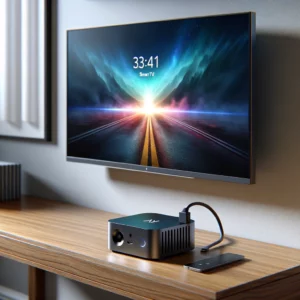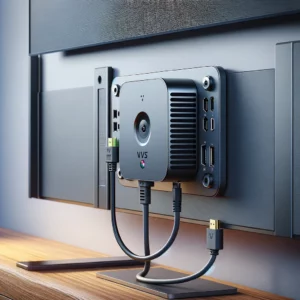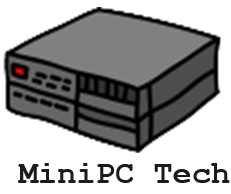
How to connect a mini pc to TV with HDMI sounds like such a basic question. But, it’s not that simple. What IS an HDMI connection? What if the TV doesn’t have one available? What if the mini PC doesn’t have one? What if they are too far apart?? And why should I even care about HDMI??
There are so many ways a mini-PC can transform your entertainment experience. Whether it’s binge-watching your favorite series or getting the upper hand in the latest video games, connecting your PC to a TV is a game-changer. You get the advantage of using the power of a smart TV with an HDMI connection as a computer monitor. If it’s a 4k TV with all of the display options that come with it, it can open up a whole new world for entertainment, gaming, and education!
Why Use HDMI to Display Your Computer Screen Anyway?
The pivotal role of HDMI in this setup lies in its ability to deliver high-definition audio and video through a single cable. HDMI is an industry standard for transmitting video and audio from one device to another. There are two versions of the standard HDMI 1 was created mostly for transmitting DVD video and audio and has been largely superseded by HDMI 2. HDMI 2 is the standard most smart TVs support now, and with good reason. HDMI 2 allows you to transmit 4K video at speeds up to 60 frames per second. A newer standard, HDMI 2.1, takes that to the next level and supports 4K video at up to 240 frames per second. That speed is critical for gaming and sports viewing.
Now, this isn’t just about watching content; it’s also about the sleek, unobtrusive form factor of mini-PCs being an elegant addition to your living room, without a tangle of wires disrupting your space. But of course, the first step is getting everything properly connected.
There’s a lot of opportunity in using your mini-PC as a media hub, and HDMI connectivity is at the heart of it. That being said, I’m here to guide you through the process. In this section, we’ll lay the groundwork by discussing the significance and fundamentals of how to connect your computer to your TV via HDMI.
Direct Connect: A Straightforward Way To Connect Your Mini PC to A Smart TV Via HDMI
I’m going to take you through the process to easily connect your Mini PC to TV using the most common method: the HDMI to HDMI connection. This is the go-to setup for a hassle-free way to begin streaming videos or playing games on a bigger screen.
Choosing the Right HDMI Cable
So let’s get down to it and go through the steps to connect a computer to a smart TV using an HDMI cable!
Firstly, what you’ll need is a high-speed HDMI cable. This type of cable is capable of handling high-definition video and audio, making it perfect for a seamless entertainment experience. Ensure that the cable match the HDMI specifications of both your mini-PC and TV for optimal performance.
Connecting your Mini PC to TV with HDMI Port of a Smart TV using an HDMI Cable

Now, follow these simple steps to use an HDMI cable to connect your mini pc to a smart TV:
1. Power off your mini-PC and TV before connecting to avoid any electrical mishaps.
2. Select the HDMI output port on your mini-PC and the HDMI input on your TV. These are usually labeled clearly.
3. Connect the HDMI cable from your mini PC to your TV.
4. Power on both devices. Set your TV to the correct HDMI input channel using the remote control. This might be labeled as ‘HDMI 1,’ ‘HDMI 2,’ etc., depending on how many ports your TV has.
5. Your mini-PC should automatically detect the TV. If not, you can adjust the display settings on your mini-PC to ensure it recognizes the TV as a monitor.
If you’re facing any difficulties with the connection, don’t worry too much about it. They can often be resolved by checking the cable connections, making sure the correct input channel is selected on your TV, or restarting your mini-PC.
Once connected, you can enjoy a variety of content on a larger screen on your tv with higher resolution. It’s a game-changer for movie nights and multiplayer gaming sessions!
But what if your mini-PC doesn’t have an HDMI port? Well, there are numerous alternatives for connecting your device to an HDMI display, and you’re going to find out about them next. From USB to HDMI adapters to wireless HDMI extenders, I’ll cover the adapters and strategies you can use to get your mini-PC up and running with your TV in no time.
Alternative Adapters and Converters For Your Mini PC
Using Adapters: USB, DisplayPort, and mini DisplayPort
Not all mini-PCs come equipped with an HDMI port, which might seem like a hurdle at first. However, there’s a silver lining – you can use an adapter! There are a multitude of adapter options that can bridge the gap between your device and a seamless TV connection. Let’s explore some of the most commonly used adapters and converters that can turn your mini-PC’s available port into an HDMI-compatible output.
For mini-PCs boasting USB ports, a straightforward solution is a USB to HDMI adapter. Such adapters convert the USB output to HDMI, allowing your mini-PC to communicate with your TV as if it had a native HDMI port.
DisplayPort to HDMI adapters are ideal for mini-PCs that come with DisplayPort outputs. These small yet powerful devices translate the DisplayPort signal into an HDMI one, making the connection to your TV possible without any loss in quality.
If you’re working with a smaller device that includes a mini DisplayPort, don’t worry. Mini DisplayPort to HDMI adapters are also available and follow the same principle of converting signals between the two formats, ensuring you don’t miss out on high-definition content.
Harnessing the latest tech with USB-C and Thunderbolt adapters
The introduction of USB-C has been a game-changer for many tech enthusiasts. If your mini-PC has a USB-C port, you’re in luck. USB-C to HDMI adapters not only carry video signals but support high-resolution output catering to modern displays, making them a go-to choice for clear, vibrant visuals.
Converting signals with VGA to HDMI converters
VGA may seem like a relic from the past, but many mini-PCs still come with VGA outputs. If that’s all you have, a VGA to HDMI converter will become your best friend. Note that these are more complex than cables as they convert analog signals to digital. Consequently, you might need an additional audio connection for complete AV integration.
Using DVI to HDMI Cables to get the HDMI output
For those Mini PCs equipped with DVI outputs, you can use a DVI to HDMI cable to connect directly to your TV. Remember though, DVI doesn’t carry audio, so similar to VGA, an extra step is needed if you want sound with your picture.
These connections are often straightforward and hassle-free. However, it’s crucial to verify the compatibility of these adapters with your specific mini-PC model and consider the audio solutions in cases where the video port doesn’t support audio transmission.
Wireless Solutions and Multi-Device Setups
Connecting to Your Smart TV Wirelessly
In my opinion, connecting wirelessly to your TV is perfect when you’re trying to avoid cable clutter or when your TV and mini-PC are too far apart for a direct cable connection. Something like a wireless HDMI extender can send signals from your mini-PC to your TV with ease, and you don’t have to worry about hiding long cables.
Don’t worry too much about connecting multiple devices to one HDMI port on your TV. There’s a practical solution for that as well. HDMI switches and splitters can be real game-changers here, as they let you connect multiple HDMI sources to one port. Just press a button to switch between your mini-PC, game console, or other media devices.
And if you want to go all out, integrating an AV receiver into your setup isn’t just about the extra HDMI ports — it’s also going to rev up your audio experience. An AV receiver acts like a command center for all your devices, which means one HDMI cable to your TV is all that you’ll see.
For TVs that have come into the market with USB-C ports, it’s refreshing to know that they might support video input. In such cases, a simple USB-C to HDMI adapter could be your ticket to connectivity. It’s another example of how you can always adjust your approach down the road as technology evolves.
Remember, your first attempt doesn’t need to be your last. If one connection method isn’t giving you the results you’re after, try another. The technology is there to suit virtually every scenario. As you explore these solutions, choose something that resonates with you, offers convenience, and enhances your viewing or gaming experience. There’s a lot of opportunity in these various options to create a setup that’s not only functional but also sleek and modern.
So to wrap things up, I really hope that you feel more informed and confident about connecting your mini-PC to a TV, whether through a cable or wirelessly. It’s a straightforward process once you pinpoint the method that best fits your setup. Thanks for taking the time to read, and I’d love to hear how these solutions worked out for you — leave your comments and share your experience with the community!
Frequently Asked Questions
Why should I connect a Mini PC to my TV?
Connecting a Mini-PC to your TV can greatly enhance your viewing experience. It allows you to stream content, play games, and utilize apps on a bigger screen.
How can I set up my Mini PC for the best performance?
You can optimize your Mini-PC for best performance by ensuring it has the latest updates, adjusting its power settings for high performance, and closing unnecessary applications that could slow it down.
How can I connect my Mini PC to TV with HDMI?
To connect your computer to your TV using HDMI, simply plug one end of the HDMI cable into your Mini-PC and the other end into your TV’s HDMI port. Then, select the correct HDMI input on your TV.
What is the benefit of connecting a Mini PC to TV with HDMI?
Using HDMI to connect a Mini PC to a TV allows for high definition video and audio to be transmitted through a single cable. This can enhance the quality of your media and create a more immersive viewing experience.
How can I maximize my Mini PC and TV integration experience?
To maximize your Mini-PC and TV integration experience, ensure your devices are updated and set for optimal performance. Use a quality HDMI cable for connection and explore all the functionalities that the Mini-PC and TV offers such as streaming services, games, and other applications.
Do I need a specific type of TV to connect my Mini PC?
No, you don’t need a specific type of TV. However, your TV must have an HDMI port to connect your Mini PC using an HDMI cable. Most modern TVs have this feature.
Can the Mini PC replace my regular television service?
While a Mini-PC can provide a range of functionalities including streaming services, it might not completely replace your regular television service. It largely depends on your viewing habits and the specific services you subscribe to.

I am a retired software engineer with experience in a multitude of areas including managing AWS and VMWare development environments. I bought a relative a mini-PC a year ago and have become passionate about the technology and its potential to change how we deploy software.
